Hi! I'm Andrea, an artist who loves ceramics and sewing. Like many small artists, I've struggled with promoting and selling my work—so this blog is my journey to figure it out and help you do the same!For more of my ceramics, check out my instagram @awgpottery :)
Don't wanna be here? Send us removal request.
Text
Where to Sell Your Handmade Work: Online vs. In-Person
Now that you’ve priced your work, built your brand, and have a body of work, the next step is deciding where to sell your creations. Whether you're looking to reach a wider audience or engage more directly with customers, the options can be overwhelming. There are several online platforms and in-person opportunities, each with its own benefits and challenges. Here’s a breakdown of the pros and cons of some of the options to help guide your decision.
Case Study: awgpottery!
I haven't sold much online yet, but I do have an Instagram where I occasionally get requests and inquiries. It's been a great tool for connecting with potential buyers and showcasing my work in a more personal, engaging way. Over time, I've been learning how to use social media for sales, and I think it's a great platform for sharing both finished pieces and behind-the-scenes content to build a following.
One of my more successful experiences with selling was having my work featured in a local gallery back in high school (looking back, crazy I was 17 for all of this!). While the gallery took a 50% commission, I managed to sell all of the pieces I was showing!! What was even more valuable than the sales, however, was the exposure and credibility I gained. Having my pieces displayed in a professional space helped me establish my reputation within the art community, and earned me a scholarship to a local art college! (spoiler alert: I did not go to art school, but still, it was cool)

My silly little gallery setup from oh-so-many years ago!
Online Platforms
Anyways, back to the post! Selling online offers the ability to reach a global audience and generate passive sales. However, it comes with challenges such as platform fees, the need for strong photography, and marketing efforts. Here’s a look at some of the most common online platforms for selling handmade goods.
Etsy
Pros:
Etsy has a built-in audience specifically looking for handmade and unique items.
Easy to set up with tools for inventory management and shipping.
Handles payment processing for you, streamlining transactions.
Cons:
Etsy charges listing and transaction fees, which can add up quickly.
The platform is crowded, meaning your work can get lost in search results unless you actively market it and use good keywords.
Etsy has recently been flooded with drop-shippers and has been losing it's prestige (in my opinion).
Best For: Artists who want to tap into an established market but are okay with paying fees and putting in extra effort to get noticed.
Instagram
Pros:
Instagram is a highly visual platform perfect for showcasing your handmade work.
Direct engagement with customers through DMs and comments builds a loyal following.
You can post photos, behind-the-scenes content, and customer testimonials, making it easy to create an engaging brand presence. There are as many ways to use Instagram as there are artists!
Cons:
While Instagram is free to use, it doesn’t have a built-in e-commerce system unless you set up Instagram Shopping.
Requires consistent posting and engagement, which can be time-consuming and tiring.
Best For: Artists who want to grow their brand, interact directly with their audience, and build a community around their work.
Personal Website (Shopify, Squarespace, etc.)
Pros:
A personal website offers full control over branding, design, and the user experience.
You aren’t competing with other artists on the same platform, which makes your work the primary focus.
You can integrate a blog, showcase your portfolio, and even add a mailing list to build your customer base.
Cons:
Traffic doesn’t come automatically; you need to invest in SEO, marketing, and ads to drive potential buyers to your site.
Website hosting services like Shopify or Squarespace come with monthly fees, in addition to payment processing costs.
Best For: More experienced artists who want to establish a professional online store and take full ownership of their brand.
In-Person Sales
While online sales are convenient, in-person sales offer the unique opportunity to connect directly with customers, build relationships, and get immediate feedback. In-person selling can often lead to higher price points because customers can touch, feel, and see the quality of your work in person. However, it also requires more time and effort for setup, travel, and networking.
Markets (Craft Fairs, Art Shows, Farmers Markets)
Pros:
Direct interaction with customers allows for immediate sales and feedback.
Customers can see and feel your work, which can create a stronger connection and justify higher prices.
You have the chance to engage with a variety of people, increasing your exposure.
You can meet other artists!
Cons:
There are usually booth fees, travel costs, and setup expenses.
Foot traffic is unpredictable, and depending on the market, sales may vary and you may be competing with artists whose work is similar to yours.
Requires time and effort to manage stock and engage with customers in person.
Best For: Artists who enjoy meeting customers and want to make immediate sales.
Galleries
Pros:
Galleries provide a platform for selling high-end artwork at a higher price point.
Your work will be curated, which can boost its prestige and increase its perceived value.
You don’t have to handle individual sales—galleries manage the process for you.
Cons:
Galleries often take a 40-50% commission on sales, which reduces your earnings.
Getting accepted into a gallery requires networking and a strong portfolio.
Galleries do not offer the same consistent exposure as other sales channels.
Best For: Artists with fine art or unique pieces who are looking to establish themselves in the art world and sell at a premium price.
Pop-Ups
Pros:
Pop-up events are temporary, flexible, and often part of larger happenings, giving you access to a wide variety of potential customers.
You can collaborate with other businesses or artists, creating exciting opportunities for cross-promotion.
Events can generate buzz and drive traffic to your website or social media accounts.
Cons:
Requires time and energy to organize, market, and participate in events.
Success depends on foot traffic, which can be unpredictable.
There are usually fees involved for space rental and promotion.
Best For: Artists looking for flexibility and exposure in short bursts, as well as those who want to create excitement around their brand.
Wrapping It Up
Selling your handmade work involves figuring out where your target audience is and what kind of sales experience you want to provide. Whether you choose to sell online through platforms like Etsy, Instagram, or your own website, or prefer the personal touch of in-person sales at markets, galleries, or pop-ups, it’s essential to understand the benefits and drawbacks of each option. The best strategy for you might involve a combination of these sales methods, allowing you to reach both local and global buyers while building a strong, recognizable brand.
What’s been your experience with selling your work online or in person? Let’s talk about it in the comments! :) <3
0 notes
Text
Also, a super important point—if you feel like you need a break, take it! Like OP mentioned, nothing crushes the soul and creative process quite like a lack of positive feedback. If that’s where you’re at, step back and give yourself the space you need!
I cannot express enough that if your reaction, as a hobby artist, to not getting that many notes on your art is to say "maybe I should just stop doing art altogether" you need to stop posting art to tumblr
not necessarily forever, not even for long, but just stop putting your art on here and start doing it for you again, remember why you enjoyed doing art in the first place and stop relying on the attention of faceless people on the internet for your enjoyment of your hard work
believe me, I get it, nothing crushes the artistic soul quite like labouring for hours on a piece only for it to get like 10 notes, so you need to find your own source of joy in the act of creation and a lot of the time that means making art and not showing it to anybody
3K notes
·
View notes
Text
Should You Post Your Creative Process?
Unless you have a secret or proprietary technique, I’m all for sharing your process!
Sharing your process is a great way to create engaging content for social media and grow a following. People love watching reels and short videos of artists at work, it's satisfying, inspiring, and educational. Plus, it helps potential customers understand the time, effort, and skill that go into your work, which can make them more willing to pay what your art is worth.
Another awgpottery case study!
If you read my pricing post, you’ve already met my lady. But would seeing the behind-the-scenes process help you understand why I priced her at $200?
She’s one of my more well-documented pieces, but unfortunately, I don't have any pictures or videos from the very beginning. So, we’ll start here:
Phase 1 (not pictured):
I rolled out a huge slab of clay and made a cylinder, which I started to mold by hand to add shape.
Phase ~1.5: 10/10/23 (since we skipped the beginning):

Phase 2:
I added more clay to build out her body. Based on the timestamps, this step alone took almost two hours! Looks easier than it is.

Phase 3:
Another hour in, and I’ve filled in that gaping area on her side while smoothing out some of the dimpling from all the clay additions.

Phase 4 10/21/23:
I left her to slowly dry for a few days under plastic and smoothed out even more of the dimpling. I also added a slab to the bottom so she could now hold water and be used as a vase (see video). The wet newspaper on top is to help the rim from cracking while drying.

Phase 5 11/12/23
Now she's all dried out and ready to go in the bisque kiln (first firing in ceramics)!!
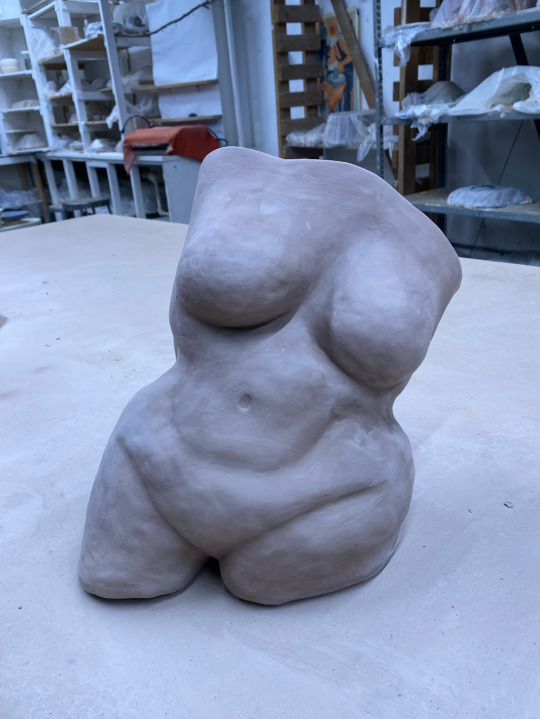
Phase 6: 11/26/23
She has been through the bisque firing and I have put glaze on, now she is ready for the final firing (almost done!!)

Phase 7: 12/8/23
Glazed and photographed—finally finished!
As you can see, this piece took me two months to make! That’s partly because I’m a student and can’t work on my pieces every day, partly because clay needs drying time, and partly because my studio has to fire my work twice (bisque and glaze).
Regardless, this piece took a huge amount of time, care, and skill—and now you can see why! Pricing isn’t just about the final product, but the entire journey behind it.

Thanks for following along on this journey! On social media, I wouldn’t typically go into this much detail unless someone asked about my process. Instead, I’d share each step in real time on my stories or create a final post with highlights from each phase. This keeps content engaging while still giving insight into the time, effort, and skill behind each piece!
That said, unless you’re positioning yourself as an educational account, it’s usually best to leave out some details of your process when posting about your work. A little mystery can go a long way!
0 notes
Text
This is adorable and such a great way to keep your brand close to potential customers!!

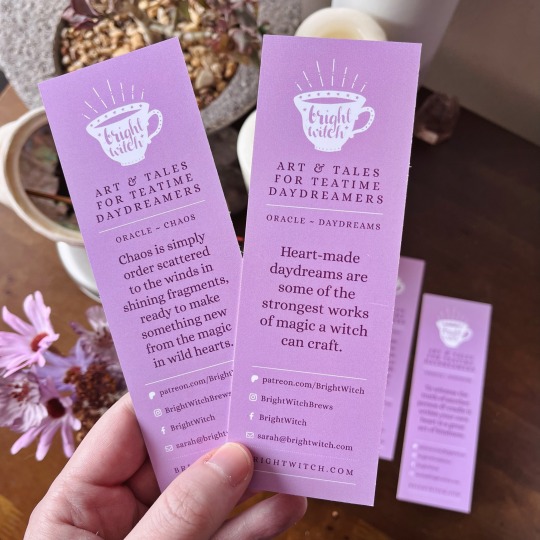
I made bookmark business cards to hand out at markets. There are four designs and they each have a little oracle message on the back ☺️
I wanted to make something that people would want to keep and get some use out of, so bookmarks with pretty art and magical messages seemed like the thing to do!
They were really popular, and a great icebreaker to bring people into the stall 💜
12 notes
·
View notes
Text
!!!
Tools That Will Help You Start Your Business For Free
ChatGPT
Canva
Stan Store
Stripe
Tiktok
Mailchimp
Pinterest
Hubspot
Capcut
Webflow
Unsplash
Google Fonts
Notion
WooCommerce
Convertkit
Calendly
Zapier
Sendinblue
Mozbar
Google Trends
Framer
YouTube
Answer The Public
IFTTT
Buffer
Videoleap
Snaptik
Google Analytics
Keyword.io
Trello
Google Docs
Instagram
Twitter
Hootsuite
Pixabay
Pexels
Wave
Grammerly
Calendly
Xero
Product Hunt
Semrush
PlaceIT
Asana
Loom
Namelix
2K notes
·
View notes
Text
Omg! This is such a helpful illustrated guide by an artist who has gone and done it!! I don't have experience with tabling so this is great!! :)
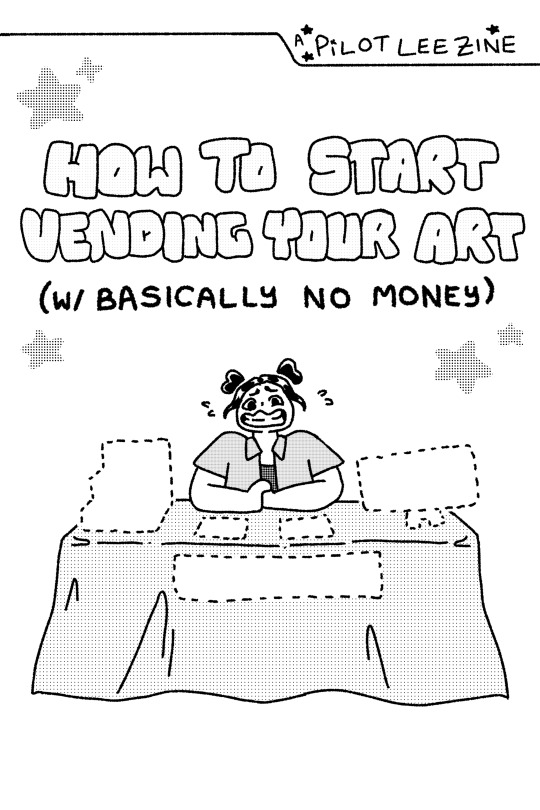
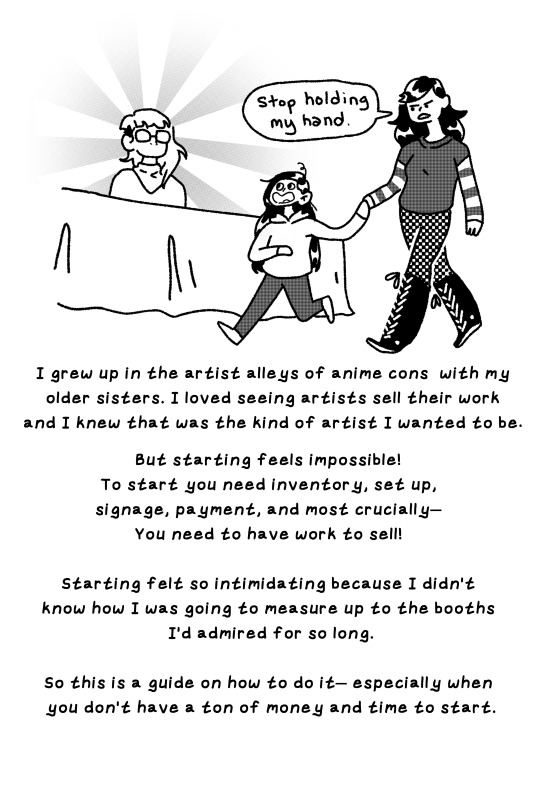

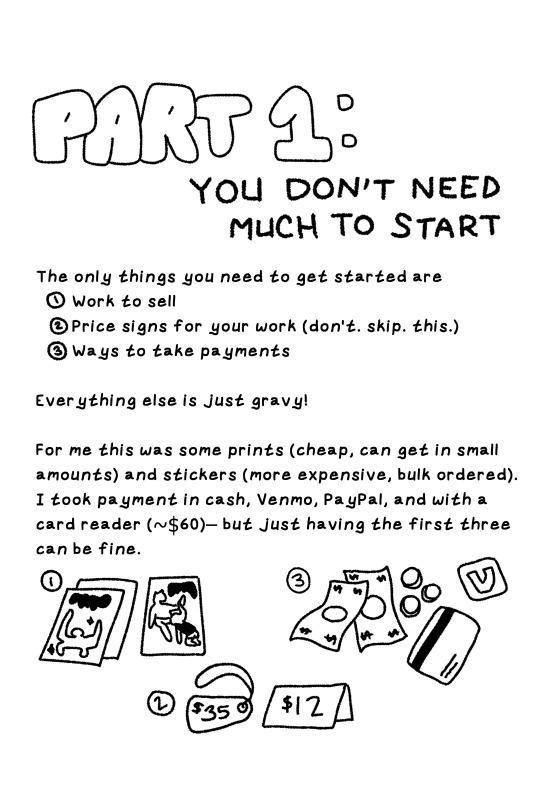

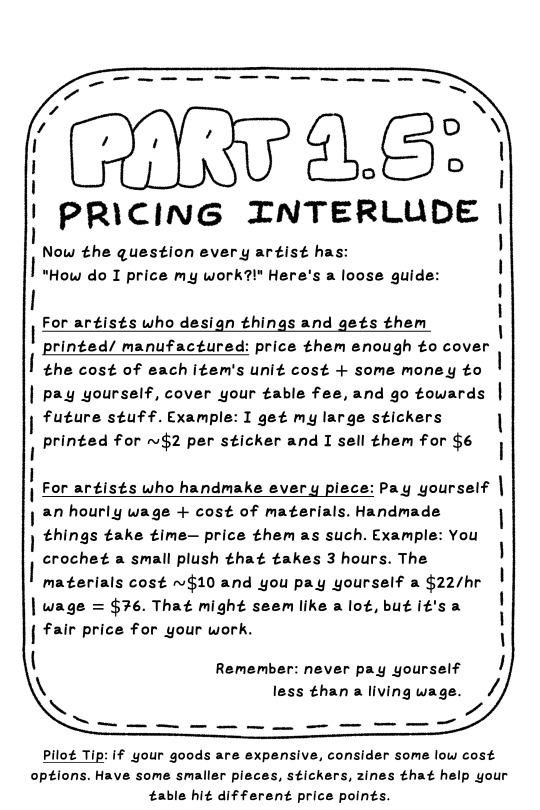





My zine on vending for the first time! I wish I hadn't waited so long to start and now hopefully others can start too!
8K notes
·
View notes
Text
Branding: How to Craft Your Persona
Building a brand is one of the most essential things you can do as an artist or small business owner. It’s not just about your logo or your product; it’s about how people perceive you, and how you connect with your audience on a deeper level. Branding is everything—your unique identity, story, and the consistent message you communicate. But what does branding really mean, and how can you create a brand that sticks? Let’s break it down.
Case Study: awgpottery!

Honestly, I still have a lot of work to do when it comes to branding! Most of my sales have been through word of mouth, and I’ve grown mostly through people I know and have met at events. Recently, I decided to standardize the signature on the bottom of my work, so one of my friends 3D-printed a stamp for me (results pictured above)! In exchange, I gave him a bowl I made. Trades like this can be such a valuable way for artists to grow and upscale their brand—otherwise, I would’ve had to buy a stamp, but this feels so much more personal and meaningful. Plus, there’s a story behind it.
I’ve always signed my work with AWG, my initials, and decided to make that part of my brand. It’s very memorable and now some of my friends jokingly refer to me as AWG (pronounced: ah-wh-Gh), so it’s really caught on. Living your brand helps too, like how I have my pottery Instagram linked in the bio of my personal Instagram. That little cross-promotion has really helped my ceramics business grow!
I’m not the best example of social media marketing yet, as I haven’t dedicated much time to it, but here are some tips I’ve picked up from my research!
What is Branding, and Why is It Important?
At its core, branding is the way you present yourself to the world. It's the emotional connection you create with your audience through your products, messages, and experiences. In the art world and for small businesses, branding sets you apart. It shows potential buyers why your art (or your business) is unique, why it matters, and why they should choose you over the competition.
Branding is more than just a logo or catchy tagline. It’s how you’re perceived across all touchpoints—social media, your website, packaging, and even in-person interactions. Good branding creates trust, recognition, and loyalty.
Story Marketing: Crafting Your Narrative
One of the most powerful ways to market your brand is through storytelling. People connect with stories, they remember and relate to them. As an artist or small business, you’re not just selling a product, you’re sharing a piece of yourself. Your journey, your struggles, your triumphs—these are what make your brand human and relatable.
Think about the story behind your work. What inspired your art? Why did you start your business? These are the questions that shape your narrative. Share your process, your challenges, and your goals, here a little vulnerability can go a long way. This will resonate with your audience and create a personal connection.
Know Your Audience
Before you dive into marketing, it’s crucial to understand who you’re talking to. Who are they? What are their needs? What do they want from you, and why are you the one they should turn to? Are they young professionals, collectors, local art lovers, or tourists?
Knowing your audience means tailoring your brand message to resonate with them. If you’re selling high-end sculptures, your audience will be different than if you’re making affordable pottery for students. Understand what motivates them to buy, and focus on what makes your art or business align with their values and desires.
High-Level Brand Values
Your brand values are the foundation of your persona. These are the core principles that guide every decision you make in your business. They reflect who you are, what you stand for, and how you want to impact the world.
Are you about sustainability? Empowering other artists? Supporting your local community? Defining your brand values helps keep your message consistent and ensures that your actions match your words.
Making a Logo
A logo is often the first thing people will associate with your brand. It’s your visual identity. But how do you make a logo that works for you?
Start by thinking about the emotions you want your brand to evoke. Should your logo feel fun and playful, or elegant and refined? Once you’ve got that figured out, you can begin sketching out ideas or working with a designer to create something that fits. If you’re just starting and your budget is tight, there are plenty of free or affordable logo design tools available.
But when should you invest in a professionally designed logo? If branding is going to be a major part of your strategy, it’s worth putting the money into something that truly reflects your vision. A well-designed logo can elevate your brand and make a lasting impression. As an artist, you likely know other artists and maybe you can do a trade: They make a logo for you, and you give them one of your pieces!
Tone
Your tone of voice is how you communicate with your audience. It’s the personality of your brand, and it should be consistent across every platform, from your website to your social media captions.
Are you casual and laid-back, or formal and sophisticated? Your tone should reflect the personality of your brand and resonate with your audience. For example, if your target market is young, trendy professionals, you might adopt a playful, informal tone. But if you’re selling fine art to collectors, a more professional, polished tone might be appropriate.
Your tone of voice will change slightly depending on the platform, but the overall feeling should remain the same. Keep it aligned with your brand’s identity and values.
Consistency
Consistency is key to building brand recognition. Every time a potential buyer interacts with your brand—whether it’s through social media, your website, or a piece of your artwork—your message should be the same.
This means using the same color scheme, fonts, and voice across all of your channels. Consistency helps create familiarity, which builds trust with your audience. If your messaging or aesthetic changes frequently, it can confuse or alienate potential buyers. Stick to a cohesive visual and verbal identity, and your audience will start recognizing and connecting with your brand.
Engagement
Engagement is how you interact with your audience, and it’s a critical part of building a loyal customer base. Respond to comments, engage in conversations, and ask for feedback. People want to feel seen and heard. By engaging with your audience, you show them that you value their opinions and their support.
You can engage on social media, via email newsletters, or even in person at art shows or gallery events. The goal is to create a two-way dialogue—give people a reason to connect with you, and they’ll feel more invested in your brand.
Wrapping It Up
Branding is more than just a buzzword; it’s how you define yourself and connect with your audience. By understanding your story, your audience, and your values, you can create a persona that resonates with people and builds long-term loyalty. From designing a logo to maintaining consistency, every piece of your branding puzzle contributes to the bigger picture. And, remember, the best brands are the ones that engage with their audience and continue to evolve as they grow. :) <3
If you're interested in diving deeper into building your brand, here are some great resources:
Julie Erin Designs: Brand Identity for Your Art Business
RMCA Design Blog: How to Establish Your Own Brand as an Artist
Artists Network: Build Your Brand as an Artist—Tips for Success
Do you have experience with branding or marketing? As always, drop a comment and share your branding journey below! :)
0 notes
Text
Doing your market research and validating your brand is so crucial to starting a business!!
Unsure If Your Biz Idea Is Good?
Let’s get straight to the point…
You can have the best idea and all the money you need to start, and still fail! It happens every day. But chances are you’re not in a position to blow a bag of money on a failed idea.
On the flip side, you can have a ridiculous idea and no money, yet be widely successful. This doesn’t happen as often as the above scenario, but it has happened in the history of entrepreneurship. However, the chances of succeeding with all odds stacked against you are nill.
Ideally, you want, and should take, the safer more assured path. The path that confirms your business idea has the potential to be successful.
PURPOSE OF VALIDATING
Validating your business idea is based on its buying market. Take the time to answer these essential questions, and put your new business on a path to success:
Is there a buying market that wants or needs what I’m selling?
How large is my buying market?
What are the potential sales my new business could generate?
Who are my competitors, and how much do they generate in sales?
When doing traditional market research, no amount of data can tell you exactly how well your business will do, for two key reasons:
First, it is based on assumptions. In other words, guessing. Assumptions happen a lot in the business world. One can assume a business will do well, or not, based on industry history.
Secondly, it depends on you. As the Entrepreneur, you are the orchestrator and determining factor to the success of the business.
These two truths remind me of a quote that says:
It’s true. And much of business success is trial and error primarily because you need the right solutions, at the right time, with the right efforts, selling to the right market. If these steps are not working in harmony, there will be struggles in your business.
HOW TO VALIDATE YOUR BUSINESS IDEA
The method you choose largely depends on the type of business you are starting. Choose the method that connects with your audience, this will give you the realistic feedback you need to know.
Consider these methods of validation:
MARKET RESEARCH - this traditional method requires the use of market data reports gathered every 2 to 10 years. While these reports are in-depth, they are also very expensive and possibly outdated at the time you need them.
However, there are free university studies that are easy to find online. While these reports are the most current in comparison, there is no guarantee that your industry has been studied in the current year. Other the other hand, you can always ask students to choose your industry for their report. Talk to the professor at your local university.
PROTOTYPE - this common method requires a little time and money, yet the feedback is probably the most reliable. Creating a prototype, or at least the ability to show products in some way is as close as you can get to the real thing. You can survey your customers’ interest by listing the product “for sale” on your website, showing the prototype at tradeshows, or by other methods. If there is an interest then you know you can invest your time and money to bring it to market.
AUDIENCE - this reverse method is ideal for active businesses with a customer base and social media with a focused following. When you are already in business it is easy to introduce something new to your customers.
When you have a focused social media following you want to introduce products and services related to the focus. For example, NOBOSS creates content focused on entrepreneurship and starting a business. Therefore, introducing a new spreadsheet, tool, or resource for entrepreneurs would be appropriate.
The only way to know if your business idea is a great solution is to validate it. Get the facts from your customer base or focused audience. This will save you time and money, and also guide you to the paying customers that want and need what you sell.
Check out these FREE tools to get started:
Find the perfect business idea for you.
Download NOBOSS Trial version to startup!
Do the work and be successful!
5 notes
·
View notes
Text
Pricing Special Episode: M&B Flies!
Hello!! Today we have a special guest: Miles from M&B Flies! I have attached an audio clip of us talking about how he prices his flies, and his journey from Maker to Market. :)
0 notes
Text
Awesome branding advice!!
Transforming Ideas into Identity: Strategies for Powerful Branding
In today’s rapidly evolving marketplace, transforming ideas into a recognizable identity is vital for any brand aiming to carve out its niche. Powerful branding distinguishes a business, drives customer loyalty, and cultivates emotional connections with consumers. This article delves into effective strategies for branding that will not only amplify your business presence but also resonate deeply…
1 note
·
View note
Text
Mood.
uh oh the craft brainworms are in my ear again saying 'you can just make that'
14 notes
·
View notes
Text
Pricing: How to Set the ‘Right’ Price
Oh man is this a tough question! Yet, also a great starting point, as before you can sell your work, you need to assign it a monetary value, but that value isn’t always straightforward.
I want to first point out that there is no “right” price for your work, as price is incredibly subjective. It depends on a variety of factors, from the market you're in to the emotional attachment you have to your pieces. Let’s break it down with some questions to guide your thinking:
Is your market saturated with other artists? This can affect how much demand there is for your type of work. If you're in a crowded space, your price might need to reflect that.
Are you doing something very niche and hard to reproduce? The uniqueness of your work can help justify a higher price.
Are you rural or in a more populated area? Larger cities often have higher price expectations because people’s incomes are typically higher and there's a larger market of potential buyers.
What can the people in your area afford? It’s essential to think about your local economy and your target market’s budget.
Are you a novice, an expert, or somewhere in between? Your skill level plays a role. The more experienced and established you are, the higher the price you can command.
What is your brand like? If you’ve built a brand around your work, it could support a higher price point.
Do you make custom, unique pieces, or do you mass-produce? Custom and one-of-a-kind items often have a premium attached to them.
Do you want to position yourself as high-end, mid-range, or affordable? Deciding where you fall on this spectrum will influence your pricing strategy.
These are all questions to ask yourself before you even dip your toes into the numbers side. For example, in my case, I make sculptures of human bodies, which is a bit of a niche within the pottery community, whereas most people at my studio don’t sculpt at all. This influences how I think about pricing because my work is more specialized.
As you answer these questions for yourself, don’t be afraid to ask other artists—especially those with more experience—how they came up with their prices. You might be surprised at the variety of approaches.
Case Study: My Sculpture Pricing Journey

I recently went through this exact process with one of my sculptures (pictured above, Instagram link here). The dimensions of the piece are 10 in H x 6.5 in W x 8.5 in L, so it's quite substantial. I sought feedback from a few people to help me find a fair price, and the responses I received were all over the map.
My stepmom suggested pricing it around $200-250, noting that it’s large and impressive. She also mentioned that I could allow buyers to haggle or barter down if needed, which is a common practice in many art markets.
My studio manager felt it should be priced in the $150-200 range. He based this on the fact that the sculpture must have taken a significant amount of time and clay, so it needed to reflect that effort. He suggested that I think about how much clay I used and how much time it took me to get a concrete price.
A peer in my studio, who is a talented artist but hasn’t sold sculptures herself, suggested a price between $100-150. She wasn’t entirely sure, as her experience is mainly with smaller pottery, but she thought it might help the piece sell faster at a lower price.
After considering all the feedback, I ended up going with $200 because it balanced both the time I spent and the message I wanted to send with my work.
I did also have math attached to this price. I used ~ 8 lbs of clay (~$8+ firing cost would be ~$20 in materials/production costs), and it took me ~ 8 hours of work, if I pay myself a wage of $20, that would calculate out to about $200.
Looking back, I realize that my emotional attachment to the piece played a role in this decision, but there were also other factors at play. I want to market myself as a niche, mid to higher-end brand—my work is scarce because I don’t make a lot of sculptures, and my style is unique to the area. Pricing it at $200 reflected not only the craftsmanship and size but also the value I wanted to convey about my brand.
What influences the ‘right’ price?
Setting the right price is a balance of both objective factors and subjective feelings. You should use these to set a scheme you can apply to all of your work, the price should be explainable and backed up with facts and your factors. This can help you price your work consistently between similar works.
Underpricing can come from a lack of confidence. It’s easy to feel like your work doesn’t matter or isn’t good enough, but that’s simply not true! Every artist’s work holds value. It’s important to remember that the market will reflect the value you set, so don’t undersell yourself.
It can also come from a fear of rejection or devaluation. We may fear that if we price our work too high, nobody will buy it and we may attach that fear to our self-worth.
Another thing to keep in mind is that, as artists, we often assign emotional value to our pieces. We pour our hearts into what we create, and it’s hard not to get attached. However, this emotional attachment can sometimes lead to overpricing. We might price our work higher than it’s worth because we feel that it’s special or irreplaceable. While this attachment is natural, it’s important to separate it from the financial value of the piece.
That being said, if you're in a situation where you don’t need to sell your work as your main source of income, overpricing can sometimes work in your favor. Psychologically, consumers love discounts. People are more likely to buy something that’s been marked down than to purchase something at a higher price. As a result, overpricing can give you room to reduce the price later if necessary.
Okay, So How Do I Set a Price?
Now that we’ve explored the psychological factors, let’s get into the numbers. Here are a few formulas (courtesy of Art Connect Magazine) to help you get started!
1. Hourly Wage × Hours Spent + Cost of Materials
This formula gives you a basic idea of what to charge based on your time investment and material costs. Here's how it works:
Calculate how much you want to earn per hour (your hourly wage).
Multiply your hourly wage by the hours spent working on the piece.
Add the cost of materials used (clay, paint, etc.).
For example:
Hourly wage: $25
Hours spent: 10 hours
Materials cost: $50
Price = ($25 × 10) + $50 = $300
This formula is a great baseline to make sure you’re covering your costs and paying yourself for your time.
2. Height x Width × Price Per Square Inch (for 2D Art)
This is mainly used for 2D pieces like paintings or drawings. By determining a price per square inch, you can standardize your pricing based on the size of the piece. For example:
Height: 10 inches
Width: 12 inches
Price per square inch: $2
Price = (10 × 12) × $2 = $240
This pricing method works especially well for paintings or prints where size is a major factor in determining value.
3. Height + Width × Price Per Linear Inch (for 2D Art)
This formula is similar to the previous one but can work better if you use a variety of canvas sizes. It calculates the linear inches of your work, which can help you standardize pricing across different pieces. Here’s how it works:
Height: 10 inches
Width: 12 inches
Price per linear inch: $5
Price = (10 + 12) × $5 = $110
This formula is a bit simpler for pricing works that don’t have a large variation in depth or thickness.
Determining your price per square or linear inch can be tricky, especially if you have no experience with 2D works. Don’t worry! There are great resources out there to help you find a fair pricing method. Here are a couple of articles that can give you more in-depth strategies and examples:
A Simple Formula for Pricing Artwork
Pricing Your Artwork: A Guide for Beginners
Additional Pricing Strategies
Beyond the basic formulas, there are other pricing tactics you can use to influence buyers’ perception of your work.
Charm Pricing
Charm pricing is the psychological strategy of pricing a product just below a whole number. For example, instead of pricing something at $50, you would price it at $49.99. The idea is that customers perceive prices ending in .99 as being significantly cheaper, even though the difference is just a penny. This can be very useful when selling small pieces, especially at fairs or in online shops, where buyers are more likely to make impulse purchases.
However, for higher-value pieces in a more luxury market, you should avoid charm pricing. Keeping your price a clean, round number (e.g., $1500 instead of $1499) conveys confidence and is more in line with what high-end collectors expect.
Anchor Pricing
Anchor pricing involves setting a higher-priced piece as a benchmark so that your mid-range or lower-priced pieces appear like better deals. This strategy works well if your buyers are unfamiliar with your work and need some guidance on what to expect.
For example, if you have a premium piece priced at $5000, and then you have a mid-range piece priced at $2000, your buyers will view the $2000 piece as a relative bargain. By offering a range of price points, you can give customers the feeling that they are getting good value for their money.
Wrapping It Up
Pricing your work isn’t an exact science—it’s a blend of personal factors, market dynamics, and psychological strategies. By applying the formulas above and considering the different pricing techniques, you’ll be able to create a pricing structure that works for you and resonates with your target audience. Always keep in mind that your price should reflect both your time and the value you place on your art, but it also needs to be flexible enough to adapt to your changing market and goals.
What are your thoughts on pricing your work? Have you tried any of these formulas or strategies? Drop a comment or share your pricing journey below! :) <3
0 notes
Text
Meet the Author!
Hi! My name is Andrea—welcome to my blog!
I’ve been working with pottery and ceramics for about seven years (I started in high school!) and picked up sewing last August. I’ve also dabbled in glassblowing, painting, drawing, and jewelry making—though some of those have been harder to access or just didn’t stick with me.
In college (where I still am, by the way!), I helped start a ceramics club on campus and taught Saturday studio sessions. While I loved being part of that community, I eventually stepped away due to health reasons.
I know personally how hard it can be to put a price on your work or to start selling handmade goods. That's why I want to explore the journey from Maker to Market—how artists, including myself and my friends, have navigated making and selling handmade goods. I’ll be sharing insights on pricing your work, growing a following, marketing your products, and anything else that comes up (including follower requests!).
If you have any questions or topics you'd like to see covered, feel free to reach out!
That’s all for now—thank you for joining me on this journey! :) PS. I added a few photos of my work :)



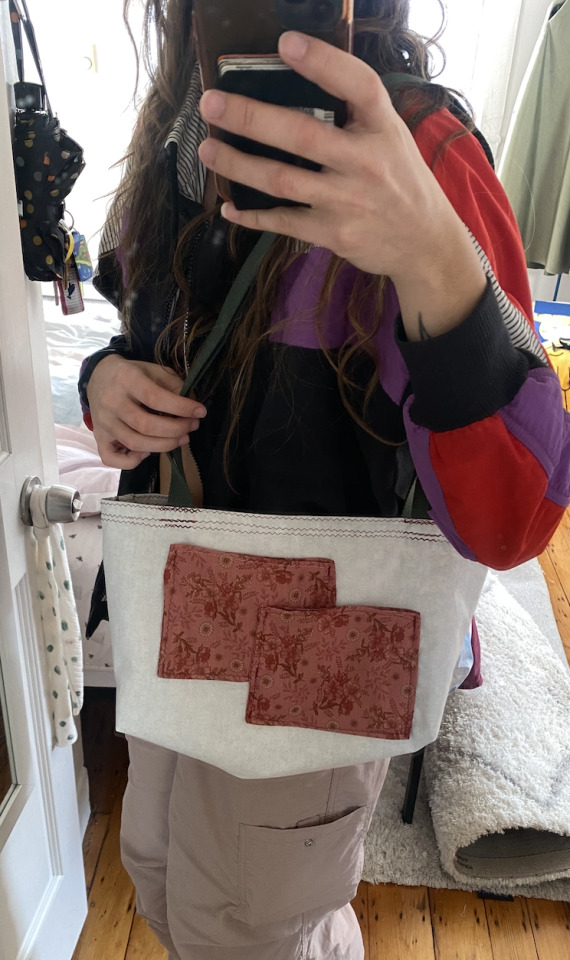



1 note
·
View note